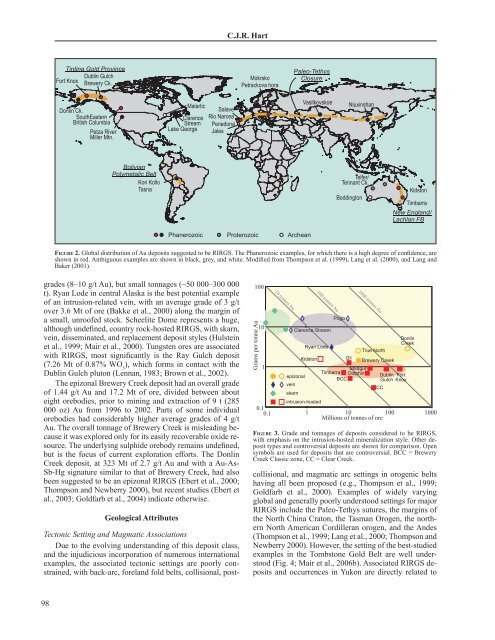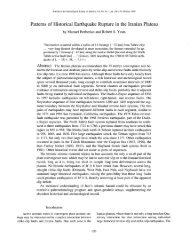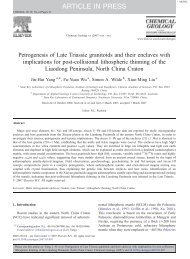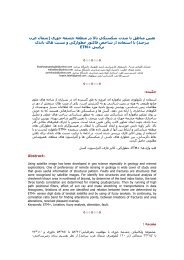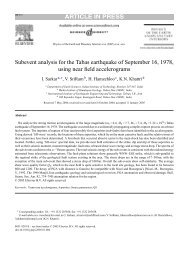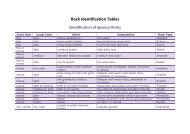Reduced Intrusion-Related Gold System - GSINET | Geological ...
Reduced Intrusion-Related Gold System - GSINET | Geological ...
Reduced Intrusion-Related Gold System - GSINET | Geological ...
Create successful ePaper yourself
Turn your PDF publications into a flip-book with our unique Google optimized e-Paper software.
C.J.R. Hart<br />
Tintina <strong>Gold</strong> Province<br />
Dublin Gulch<br />
Fort Knox Brewery Ck.<br />
Mokrsko<br />
Petrackova hora<br />
Paleo-Tethys<br />
Closure<br />
Donlin Ck.<br />
SouthEastern<br />
British Columbia<br />
Petza River<br />
Miller Mtn.<br />
Malartic<br />
Clarence<br />
Stream<br />
Lake George<br />
Salave<br />
Rio Narcea<br />
Penedona<br />
Jales<br />
Vasilkovskoe<br />
Niuxinshan<br />
Bolivian<br />
Polymetalic Belt<br />
Kori Kollo<br />
Tasna<br />
Telfer/<br />
Tennant Ck.<br />
Boddington<br />
Kidston<br />
Timbarra<br />
New England/<br />
Lachlan FB<br />
Phanerozoic Proterozoic Archean<br />
FIGURE 2. Global distribution of Au deposits suggested to be RIRGS. The Phanerozoic examples, for which there is a high degree of confidence, are<br />
shown in red. Ambiguous examples are shown in black, grey, and white. Modified from Thompson et al. (1999), Lang et al. (2000), and Lang and<br />
Baker (2001).<br />
grades (8–10 g/t Au), but small tonnages (~50 000–300 000<br />
t). Ryan Lode in central Alaska is the best potential example<br />
of an intrusion-related vein, with an average grade of 3 g/t<br />
over 3.6 Mt of ore (Bakke et al., 2000) along the margin of<br />
a small, unroofed stock. Scheelite Dome represents a huge,<br />
although undefined, country rock-hosted RIRGS, with skarn,<br />
vein, disseminated, and replacement deposit styles (Hulstein<br />
et al., 1999; Mair et al., 2000). Tungsten ores are associated<br />
with RIRGS, most significantly is the Ray Gulch deposit<br />
(7.26 Mt of 0.87% WO 3<br />
), which forms in contact with the<br />
Dublin Gulch pluton (Lennan, 1983; Brown et al., 2002).<br />
The epizonal Brewery Creek deposit had an overall grade<br />
of 1.44 g/t Au and 17.2 Mt of ore, divided between about<br />
eight orebodies, prior to mining and extraction of 9 t (285<br />
000 oz) Au from 1996 to 2002. Parts of some individual<br />
orebodies had considerably higher average grades of 4 g/t<br />
Au. The overall tonnage of Brewery Creek is misleading because<br />
it was explored only for its easily recoverable oxide resource.<br />
The underlying sulphide orebody remains undefined,<br />
but is the focus of current exploration efforts. The Donlin<br />
Creek deposit, at 323 Mt of 2.7 g/t Au and with a Au-As-<br />
Sb-Hg signature similar to that of Brewery Creek, had also<br />
been suggested to be an epizonal RIRGS (Ebert et al., 2000;<br />
Thompson and Newberry 2000), but recent studies (Ebert et<br />
al., 2003; <strong>Gold</strong>farb et al., 2004) indicate otherwise.<br />
<strong>Geological</strong> Attributes<br />
Grams per tonne Au<br />
100<br />
10<br />
1<br />
0.1<br />
0.1<br />
10 tonnes Au<br />
epizonal<br />
vein<br />
skarn<br />
Ryan Lode<br />
Kidston<br />
intrusion-hosted<br />
100 tonnes Au<br />
Clarence Stream<br />
Pogo<br />
Shotgun<br />
Timbarra Dolphin<br />
BCC<br />
Donlin<br />
Creek<br />
Dublin Fort<br />
Gulch Knox<br />
1 10 100 1000<br />
Millions of tonnes of ore<br />
Tectonic Setting and Magmatic Associations<br />
Due to the evolving understanding of this deposit class,<br />
and the injudicious incorporation of numerous international<br />
examples, the associated tectonic settings are poorly constrained,<br />
with back-arc, foreland fold belts, collisional, postcollisional,<br />
and magmatic arc settings in orogenic belts<br />
having all been proposed (e.g., Thompson et al., 1999;<br />
<strong>Gold</strong>farb et al., 2000). Examples of widely varying<br />
global and generally poorly understood settings for major<br />
RIRGS include the Paleo-Tethys sutures, the margins of<br />
the North China Craton, the Tasman Orogen, the northern<br />
North American Cordilleran orogen, and the Andes<br />
(Thompson et al., 1999; Lang et al., 2000; Thompson and<br />
Newberry 2000). However, the setting of the best-studied<br />
examples in the Tombstone <strong>Gold</strong> Belt are well understood<br />
(Fig. 4; Mair et al., 2006b). Associated RIRGS deposits<br />
and occurrences in Yukon are directly related to<br />
Gil<br />
1000 tonnes Au<br />
True North<br />
Brewery Creek<br />
FIGURE 3. Grade and tonnages of deposits considered to be RIRGS,<br />
with emphasis on the intrusion-hosted mineralization style. Other deposit<br />
types and controversial deposits are shown for comparison. Open<br />
symbols are used for deposits that are controversial. BCC = Brewery<br />
Creek Classic zone, CC = Clear Creek.<br />
CC<br />
98


